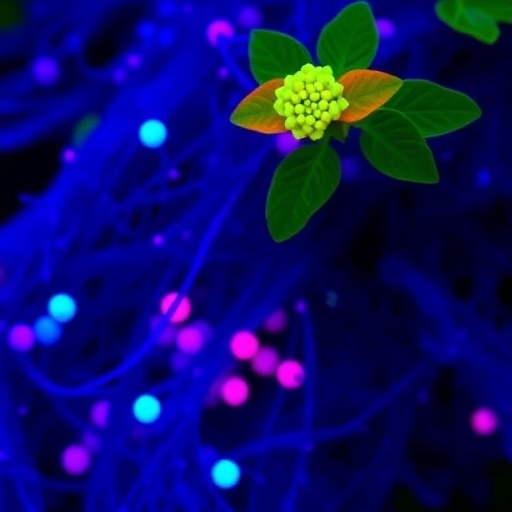In an exciting development within the field of cancer research, recent investigations have yielded new insights into the anti-cancer properties of the revered medicinal plant, Withania somnifera, commonly known as ashwagandha. This ancient herb, celebrated for its adaptogenic qualities, has been the subject of numerous preclinical studies that underscore its potential against various malignancies. Recent research, however, delves deeper, focusing specifically on its impact on neuroblastoma, a formidable childhood cancer that arises from immature nerve cells.
The study, spearheaded by a dynamic team of researchers, employs bioactivity-guided fractionation—a sophisticated technique where extracts from Withania somnifera roots are meticulously separated to isolate the most potent bioactive compounds. This method not only enhances the understanding of the extract’s pharmacological properties but also paves the way for identifying specific components that may be responsible for therapeutic effects. Researchers have previously hinted at the herb’s attributes in modulating stress responses and inflammation, yet its direct implications for neuroblastoma treatment had remained largely uncharted territory.
Neuroblastoma is notorious for its aggressive nature and tendency to metastasize, contributing significantly to cancer-related morbidity in children. The urgency to explore novel therapeutic avenues has intensified, prompting researchers to scrutinize natural products as a viable solution. By leveraging the rich biochemical diversity within Withania somnifera, scientists are beginning to uncover a wealth of information that could potentially revolutionize treatment strategies for this elusive cancer type.
One of the standout findings from the research is the identification of specific alkaloids and steroidal lactones derived from the root extract that demonstrate remarkable cytotoxicity against the human Kelly neuroblastoma cell line. These compounds, known as withanolides, have been linked to apoptosis, or programmed cell death, in cancerous cells. This discovery not only emphasizes the promise of Withania somnifera as a chemotherapeutic agent but also raises questions about the mechanisms underlying its effectiveness when faced with complex cancer cell behaviors.
The implications of these findings extend beyond simple tumoricidal activity. The ability of Withania somnifera compounds to induce apoptosis without significantly harming normal cells is a critical aspect of developing safer and more selective cancer therapies. Traditionally, many chemotherapy agents are indiscriminate, affecting both malignant and healthy cells alike, leading to debilitating side effects. The selective cytotoxicity observed in this study could signify a shift towards more targeted therapeutic strategies that spare healthy tissues while effectively combating cancer.
Moreover, the research also addresses the potential synergistic effects of combining Withania somnifera extracts with conventional chemotherapy regimens. The addition of natural compounds to existing cancer treatments could enhance the overall efficacy and reduce the likelihood of drug resistance, a common challenge in managing neuroblastoma. Preliminary investigations suggest that the integration of these natural constituents may lead to a multi-faceted approach in cancer therapy, leveraging the strengths of both botanical therapies and traditional medicine.
The study’s rigor includes an evaluation of the extract’s pharmacokinetics and bioavailability, crucial factors that influence therapeutic outcomes. Understanding how these compounds are absorbed, metabolized, and excreted is essential for optimizing their use in clinical settings. Researchers are keenly aware that efficacy in vitro does not always translate effectively in vivo, and hence, the exploration of these pharmacological dynamics is paramount for future translational research.
Alongside the laboratory-based findings, the cultural and historical significance of Withania somnifera cannot be overlooked. Revered in Ayurvedic medicine for millennia, ashwagandha is considered a rejuvenating herb, believed to enhance vitality and longevity. This traditional knowledge combined with modern scientific investigation highlights the potential for integrating ancient wisdom with contemporary therapeutic practices, fostering a holistic approach to cancer treatment.
As the research progresses, questions surrounding dosage, administration routes, and potential interactions with existing medications remain focal points for future studies. These aspects are crucial to paving the way for clinical trials that could test the effectiveness of Withania somnifera in real-world therapeutic contexts. The path from laboratory bench to bedside is often fraught with challenges, yet the compelling evidence from this study offers a beacon of hope amid the often daunting landscape of cancer treatment.
In summary, this groundbreaking research on Withania somnifera sheds light on the complexities and applications of natural products in combatting neuroblastoma. By unraveling the intricate relationship between the bioactive components of this revered plant and their potential therapeutic effects, scientists are igniting a new dialogue on the future of cancer treatment. The findings prompt a reassessment of traditional botanical remedies, positioning them not merely as complementary therapies but as integral components of modern oncological practices.
The implications of this research hold promise not only for children battling neuroblastoma but also for advancing our overall understanding of cancer biology and treatment strategies. As the scientific community continues to explore these tantalizing avenues, the ultimate goal remains clear: to develop effective, tailored therapies that improve patient outcomes and offer new avenues of hope.
The multi-disciplinary approach engaged in this study, combining phytochemistry, molecular biology, and pharmacology, serves as a model for future research initiatives aimed at demystifying the vast array of phytochemicals in medicinal plants. As researchers delve deeper into biodiversity, they are likely to uncover more natural compounds with significant therapeutic potential, further enriching our arsenal against cancer.
In conclusion, the bioactivity-guided fractionation of Withania somnifera represents a significant step forward in understanding how nature’s solutions can be harnessed for modern medicine. With ongoing research, it is hoped that the extraordinary attributes of this ancient herb can be fully realized, providing new strategies in the unyielding fight against neuroblastoma and beyond.
Subject of Research: The anti-progressive potential of Withania somnifera extracts on neuroblastoma cells.
Article Title: Bioactivity-guided fractionation of Withania somnifera (L.) Dunal roots extract: evaluation of the anti-progressive potential on human Kelly neuroblastoma cell line.
Article References:
Al-Hasawi, N.A., Al-Tannak, N.F., Joy, J. et al. Bioactivity-guided fractionation of Withania somnifera (L.) Dunal roots extract: evaluation of the anti-progressive potential on human Kelly neuroblastoma cell line.
BMC Complement Med Ther 25, 267 (2025). https://doi.org/10.1186/s12906-025-05018-2
Image Credits: AI Generated
DOI:
Keywords: Neuroblastoma, Withania somnifera, cancer research, bioactivity, phytochemistry, natural compounds, chemotherapeutics, oncology.




